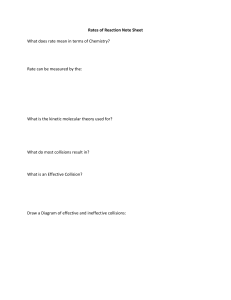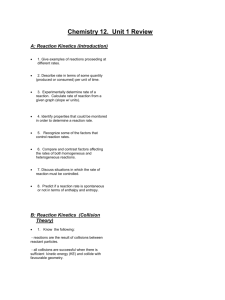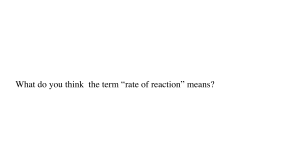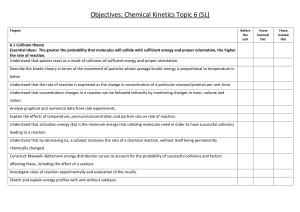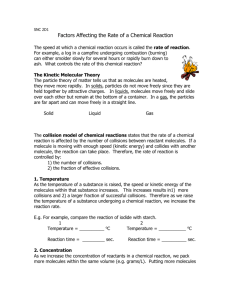Topic 6: Chemical kinetics 7 hours
advertisement
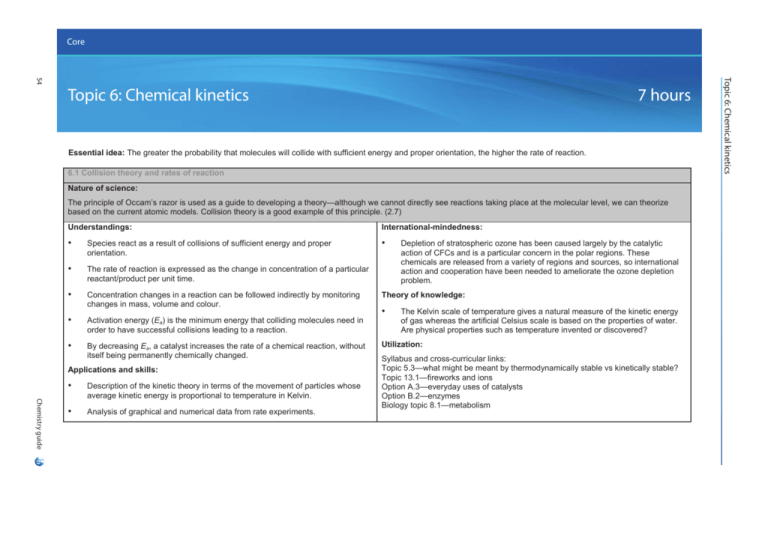
Core 7 hours Essential idea: The greater the probability that molecules will collide with sufficient energy and proper orientation, the higher the rate of reaction. 6.1 Collision theory and rates of reaction Nature of science: The principle of Occam’s razor is used as a guide to developing a theory—although we cannot directly see reactions taking place at the molecular level, we can theorize based on the current atomic models. Collision theory is a good example of this principle. (2.7) Understandings: International-mindedness: • Species react as a result of collisions of sufficient energy and proper orientation. • • The rate of reaction is expressed as the change in concentration of a particular reactant/product per unit time. • Concentration changes in a reaction can be followed indirectly by monitoring changes in mass, volume and colour. • Activation energy (Ea) is the minimum energy that colliding molecules need in order to have successful collisions leading to a reaction. • By decreasing Ea, a catalyst increases the rate of a chemical reaction, without itself being permanently chemically changed. Applications and skills: Chemistry guide • Description of the kinetic theory in terms of the movement of particles whose average kinetic energy is proportional to temperature in Kelvin. • Analysis of graphical and numerical data from rate experiments. Depletion of stratospheric ozone has been caused largely by the catalytic action of CFCs and is a particular concern in the polar regions. These chemicals are released from a variety of regions and sources, so international action and cooperation have been needed to ameliorate the ozone depletion problem. Theory of knowledge: • The Kelvin scale of temperature gives a natural measure of the kinetic energy of gas whereas the artificial Celsius scale is based on the properties of water. Are physical properties such as temperature invented or discovered? Utilization: Syllabus and cross-curricular links: Topic 5.3—what might be meant by thermodynamically stable vs kinetically stable? Topic 13.1—fireworks and ions Option A.3—everyday uses of catalysts Option B.2—enzymes Biology topic 8.1—metabolism Topic 6: Chemical kinetics 54 Topic 6: Chemical kinetics 6.1 Collision theory and rates of reaction Chemistry guide • Explanation of the effects of temperature, pressure/concentration and particle size on rate of reaction. • Construction of Maxwell–Boltzmann energy distribution curves to account for the probability of successful collisions and factors affecting these, including the effect of a catalyst. • Investigation of rates of reaction experimentally and evaluation of the results. • Sketching and explanation of energy profiles with and without catalysts. Guidance: • Calculation of reaction rates from tangents of graphs of concentration, volume or mass vs time should be covered. • Students should be familiar with the interpretation of graphs of changes in concentration, volume or mass against time. Aims: • Aims 1 and 8: What are some of the controversies over rate of climate change? Why do these exist? • Aim 6: Investigate the rate of a reaction with and without a catalyst. • Aim 6: Experiments could include investigating rates by changing concentration of a reactant or temperature. • Aim 7: Use simulations to show how molecular collisions are affected by change of macroscopic properties such as temperature, pressure and concentration. • Aim 8: The role that catalysts play in the field of green chemistry. Topic 6: Chemical kinetics 55
